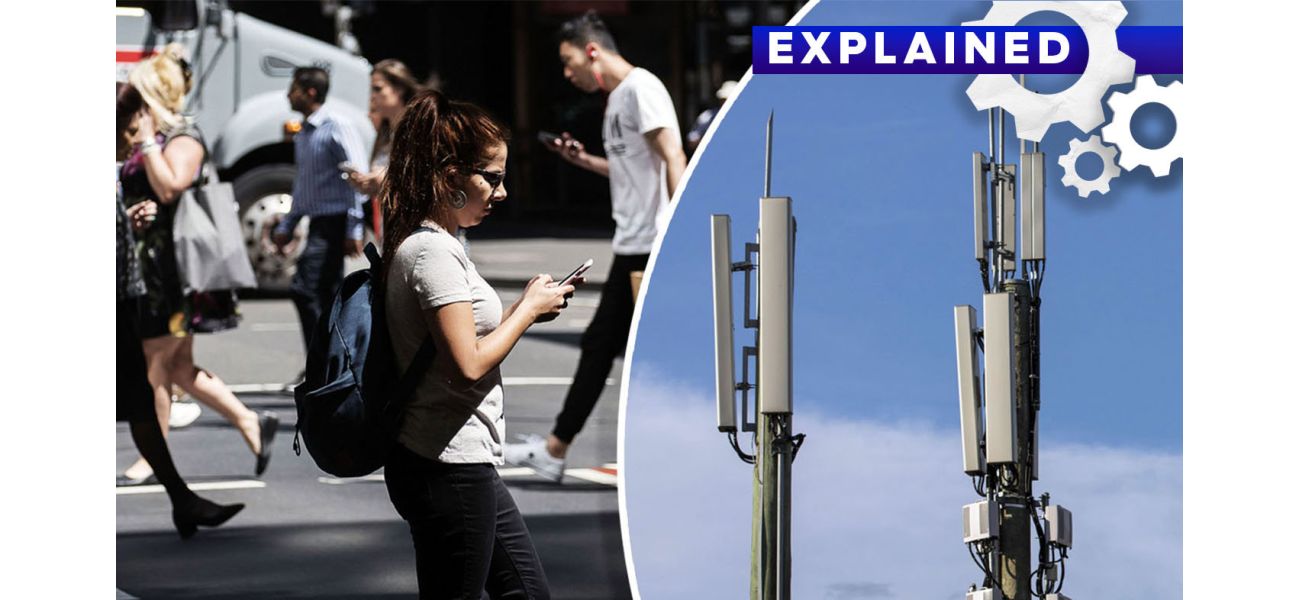Australia's 3G network is being decommissioned, here's what you need to know.
Australia's 3G networks will be completely turned off in the near future, despite being a long-standing phone coverage feature.
August 31st 2024.

As technology continues to evolve, so do our means of communication. For decades, we have relied on the 3G network for phone coverage, but in the coming months, all of Australia's 3G networks will be shutting down. This will have a significant impact on the millions of devices that rely on this network across the nation.
The shutdown began last year when Vodafone was the first telco to switch off its 3G network. Now, the next stages are about to begin with Telstra and Optus set to shut off their 3G networks in late October. This is a big change that will affect many people, so it's important to understand what's happening.
So, when exactly is the 3G network shutting down? The shutdown is happening in stages, with Vodafone already having completed theirs between December 2023 and January 2024. Telstra and Optus will follow, with all 3G services ending on October 28. Originally, Telstra was supposed to switch off on August 31, but they have since pushed back their shutdown date to give customers more time to update their devices. Optus was also supposed to shut down in September, but they have also extended their date.
Telstra's CEO and managing director, Vicki Brady, explained the reasoning behind this decision, stating, "We have to make sure everyone is ready to make this transition together – and we know some of our customers are still working through the steps they need to take to upgrade their devices. That's why we've decided to provide more time and further support."
The shutdown is estimated to affect around 3 million devices in Australia, including phones, eftpos machines, cars, tablets, and security cameras. These are mostly older devices that have been around for five or six years. It's important to note that all of these devices will stop working after the shutdown.
Additionally, the Australian government has stated that about 740,000 4G phones will be unable to call triple zero emergency services after the shutdown, as they rely on the 3G network for these calls. This number has since decreased due to efforts from Telstra and Optus to get customers to upgrade their devices, but it could still be as high as 150,000 on the Optus network alone by the time the shutdown begins.
Harvey Wright, Optus' head of new products, spoke about this during a Senate inquiry, saying, "We're still reducing the number of customers, but it could be in the order of 100,000 to 150,000."
Out of the estimated 3 million devices that will be affected, it's believed that 200,000 of them are medical alarms. David Waldie from medical alarm company Eevi stated, "An elder or someone else with a vulnerability who is relying on that alarm for an emergency response simply won't get one." This highlights the potential danger of the shutdown for those who rely on these devices for their safety.
Before the shutdown began, Vodafone reported that their 3G network carried less than one percent of its total mobile data traffic. The majority of their traffic is carried by the 4G network, making up 85 percent, while the 5G network accounts for slightly over 13 percent. A spokesperson for Vodafone stated, "We publicly announced the closure of our 3G network in September 2022 to provide 14 months' notice and plenty of support for our customers to prepare for the move to superior mobile technologies. The 3G switch-off will impact a small number of our customers who have 3G-only devices or non-VoLTE devices. Our priority through this process is to ensure they have a 4G or 5G compatible device so they can continue using our network."
There have been concerns raised about the impact of the shutdown on regional areas that don't have access to 4G or 5G networks yet. Telstra has committed to providing 4G coverage in all 3G areas before the shutdown, but Optus has made no such commitment on their website. Vodafone stated that their 4G coverage is similar in size to their 3G offering.
If you're wondering whether your device will be affected by the shutdown, the easiest way to find out is to contact the manufacturer. Stephen Fenech from Tech Guide recommends not putting off checking your device and making sure to do it as soon as possible to avoid any issues. You can also reach out to your phone provider. Customers on any network can SMS "3" to 3498, and they'll be informed by their telco if their handset needs to be updated. Optus has also released a list of their 20 most-used devices that will be impacted, including the iPhone 5, 5C, and 5S, Google Pixel 2 XL, and Samsung Galaxy S5. They are also contacting customers they believe will need to get a new device. Both Telstra and Optus have been proactive in reaching out to customers with devices that will lose functionality, and they have provided phones to those experiencing hardship.
Vodafone reported that they sent out over one million text messages and emails to their customers notifying them of the shutdown and providing information on how to upgrade their phone or device. They recommend that those with 3G-reliant or non-VoLTE devices visit their nearest Vodafone store or call 1555 to discuss upgrading their device. Companies like Eevi are also reaching out to their customers to make sure they stay connected.
If your device will be impacted by the shutdown, you'll need to purchase a replacement that is compatible with the 4G or 5G networks in order to continue accessing phone and internet services. This could simply mean changing your SIM card to a nano one or buying a new phone or other device. The reason for the 3G network shutdown is that it is no longer as widely used as it once was, with modern devices relying more on the faster 4G and 5G networks. By shutting down 3G coverage, providers like Telstra and Optus are able to repurpose the radio frequency bands used for 3G to improve and expand their 4G and 5G coverage, a process known as "re-farming."
Chris Taylor from Telstra explained, "The demand and consumption of data has been increasing exponentially. That's why we need to move our customers onto the 4G and 5G networks." This process is not unique to Australia, as similar shutdowns have happened or been announced in the UK, USA, and New Zealand.
The shutdown began last year when Vodafone was the first telco to switch off its 3G network. Now, the next stages are about to begin with Telstra and Optus set to shut off their 3G networks in late October. This is a big change that will affect many people, so it's important to understand what's happening.
So, when exactly is the 3G network shutting down? The shutdown is happening in stages, with Vodafone already having completed theirs between December 2023 and January 2024. Telstra and Optus will follow, with all 3G services ending on October 28. Originally, Telstra was supposed to switch off on August 31, but they have since pushed back their shutdown date to give customers more time to update their devices. Optus was also supposed to shut down in September, but they have also extended their date.
Telstra's CEO and managing director, Vicki Brady, explained the reasoning behind this decision, stating, "We have to make sure everyone is ready to make this transition together – and we know some of our customers are still working through the steps they need to take to upgrade their devices. That's why we've decided to provide more time and further support."
The shutdown is estimated to affect around 3 million devices in Australia, including phones, eftpos machines, cars, tablets, and security cameras. These are mostly older devices that have been around for five or six years. It's important to note that all of these devices will stop working after the shutdown.
Additionally, the Australian government has stated that about 740,000 4G phones will be unable to call triple zero emergency services after the shutdown, as they rely on the 3G network for these calls. This number has since decreased due to efforts from Telstra and Optus to get customers to upgrade their devices, but it could still be as high as 150,000 on the Optus network alone by the time the shutdown begins.
Harvey Wright, Optus' head of new products, spoke about this during a Senate inquiry, saying, "We're still reducing the number of customers, but it could be in the order of 100,000 to 150,000."
Out of the estimated 3 million devices that will be affected, it's believed that 200,000 of them are medical alarms. David Waldie from medical alarm company Eevi stated, "An elder or someone else with a vulnerability who is relying on that alarm for an emergency response simply won't get one." This highlights the potential danger of the shutdown for those who rely on these devices for their safety.
Before the shutdown began, Vodafone reported that their 3G network carried less than one percent of its total mobile data traffic. The majority of their traffic is carried by the 4G network, making up 85 percent, while the 5G network accounts for slightly over 13 percent. A spokesperson for Vodafone stated, "We publicly announced the closure of our 3G network in September 2022 to provide 14 months' notice and plenty of support for our customers to prepare for the move to superior mobile technologies. The 3G switch-off will impact a small number of our customers who have 3G-only devices or non-VoLTE devices. Our priority through this process is to ensure they have a 4G or 5G compatible device so they can continue using our network."
There have been concerns raised about the impact of the shutdown on regional areas that don't have access to 4G or 5G networks yet. Telstra has committed to providing 4G coverage in all 3G areas before the shutdown, but Optus has made no such commitment on their website. Vodafone stated that their 4G coverage is similar in size to their 3G offering.
If you're wondering whether your device will be affected by the shutdown, the easiest way to find out is to contact the manufacturer. Stephen Fenech from Tech Guide recommends not putting off checking your device and making sure to do it as soon as possible to avoid any issues. You can also reach out to your phone provider. Customers on any network can SMS "3" to 3498, and they'll be informed by their telco if their handset needs to be updated. Optus has also released a list of their 20 most-used devices that will be impacted, including the iPhone 5, 5C, and 5S, Google Pixel 2 XL, and Samsung Galaxy S5. They are also contacting customers they believe will need to get a new device. Both Telstra and Optus have been proactive in reaching out to customers with devices that will lose functionality, and they have provided phones to those experiencing hardship.
Vodafone reported that they sent out over one million text messages and emails to their customers notifying them of the shutdown and providing information on how to upgrade their phone or device. They recommend that those with 3G-reliant or non-VoLTE devices visit their nearest Vodafone store or call 1555 to discuss upgrading their device. Companies like Eevi are also reaching out to their customers to make sure they stay connected.
If your device will be impacted by the shutdown, you'll need to purchase a replacement that is compatible with the 4G or 5G networks in order to continue accessing phone and internet services. This could simply mean changing your SIM card to a nano one or buying a new phone or other device. The reason for the 3G network shutdown is that it is no longer as widely used as it once was, with modern devices relying more on the faster 4G and 5G networks. By shutting down 3G coverage, providers like Telstra and Optus are able to repurpose the radio frequency bands used for 3G to improve and expand their 4G and 5G coverage, a process known as "re-farming."
Chris Taylor from Telstra explained, "The demand and consumption of data has been increasing exponentially. That's why we need to move our customers onto the 4G and 5G networks." This process is not unique to Australia, as similar shutdowns have happened or been announced in the UK, USA, and New Zealand.
[This article has been trending online recently and has been generated with AI. Your feed is customized.]
[Generative AI is experimental.]
0
0
Submit Comment





